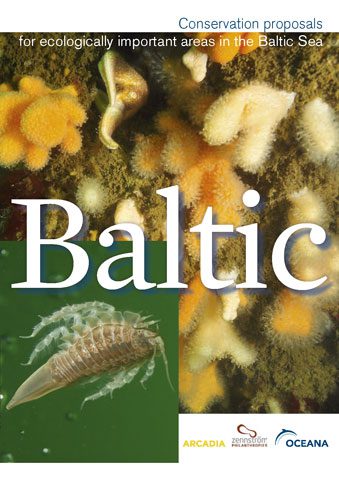Report | December, 2011
Baltic: Conservation proposals for ecologically important areas in the Baltic Sea
The Baltic Sea is one of the most peculiar seas in the world. With an average depth of only 55 meters, it is much shallower than oceans. The salinity of the Baltic Sea varies from levels similar to the ocean in Kattegat to sweetwater salinity levels in the Bay of Bothnia. Besides its unique biodiversity, the Baltic Sea is also extremely valuable to the 85 million inhabitants living in the catchment area. The coastline is shared by nine countries: Denmark, Estonia, Finland, Germany, Latvia, Lithuania, Poland, The Russian Federation, and Sweden.
Due to its brackish conditions, the Baltic Sea is a highly stressful environment for most marine organisms. Only a limited number of species have successfully colonized this special environment. The salinity is too low for most Atlantic and North Sea species, and too high for many freshwater species. Still, a mixture of marine and freshwater species has adapted to this brackish water environment. The Baltic Sea is also a relatively young sea and; therefore, colonization of species since the last glacial period is still on-going (Bonsdorff 2006). Due to these physical facts, the Baltic Sea is characterized with special biodiversity and simple systems where each species plays an important role in maintaining the structure and dynamics of the whole system. If one species disappears, it may cause irreversible damage to the whole network because no other species may have the same ecological requirements to replace the vanished one. These factors make the Baltic Sea a particularly fragile ecosystem. It is extremely vulnerable to human induced pollution and disturbances. Tragically, this fragile sea is currently considered to be one of the most polluted sea areas in the world (HELCOM 2010a). The ecosystems of the Baltic Sea are severely threatened and disturbed mainly by eutrophication, destructive fishing practices and overfishing, loss of habitats and species, inputs of harmful substance and intense maritime traffic.
In the beginning of 2011, Oceana opened a new office in Copenhagen to further concentrate its efforts on the conservation of the Baltic Sea. Work in Copenhagen started with a two month research expedition covering all of the sub-basins and countries of the Baltic Sea. In the course of the expedition, Oceana documented biodiversity and its status both inside designated marine protected areas and in areas not currently protected, some of which were identified as important marine habitats and ecosystems that deserve protection.
Oceana’s goal is to have 30 per cent of the Baltic Sea effectively conserved with well-managed marine protected areas and strictly protected no-take zones, particularly in areas with important fish habitats. This report introduces the main findings of the expedition and, based on the evidence collected, proposes new areas to be included in the current network of protected areas.




